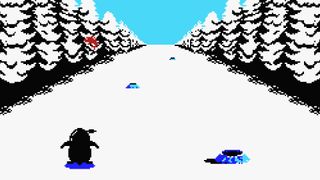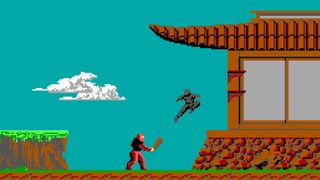The games you didn't know your favourite developer made
What studios and creators like BioWare, Blizzard, and Hideo Kojima got up to before they became famous.

It's always fun digging into the back catalogue of famous developers. Scroll back to the earliest days of their careers and you'll inevitably find something weird, whether it's a cutesy penguin platformer or a seriously off-brand mech game. Below are some surprising examples of early games by industry titans, most of which have been forgotten. Because you have to start somewhere, right?
BioWare / Shattered Steel, 1996

Before it made its name with RPGs like Mass Effect, BioWare's first ever game was a first-person mech sim called Shattered Steel. Set on a post-apocalyptic Earth where humanity is on the verge of extinction, its tagline is straight out of a Van Damme movie: "In the future, you don't rebuild. You reload." The first-person combat and customisable mechs drew similarities to the MechWarrior series, but the game was criticised for being shallow in comparison, with little complexity and a focus on brainless action. It seems BioWare took this criticism to heart; its second game, released three years later, was Baldur's Gate, a deep, sprawling RPG no one could ever accuse of being brainless.
Bethesda Softworks / The Terminator, 1991

When you hear the name Bethesda, you probably think of The Elder Scrolls. But back in 1991, three years before that series even existed, the studio made another, lesser known open world game: The Terminator. This was the first videogame based on the Terminator movies, and is set in a six-square-mile recreation of central Los Angeles: an incredible technical achievement for the time. Playing as either Kyle Reese or the T-800, you chase your target through the city streets, evading cops and stealing cars—making it, in a roundabout way, a precursor to the Grand Theft Auto series.
Hideo Kojima / Penguin Adventure, 1986

It's amazing to think that the roots of Death Stranding can be traced back to Penguin Adventure, a cute platformer released for the MSX back in 1986. This was Hideo Kojima's first gig as a game designer, working on the project as an assistant designer. You play as a penguin called Penta who's on a mission to recover a golden apple and cure Penguette, a sickly penguin princess. Hardly the greatest story Kojima has ever worked on. But, interestingly, Penguin Adventure features multiple endings, including one where Penguette dies. This may have inspired Kojima when he made Metal Gear Solid 11 years later, which has its own bad ending involving a character dying.
Blizzard Entertainment / Blackthorne, 1994

These days, Blizzard is all about Warcraft, Diablo, and Overwatch. But dig into the company's storied history and you'll find a few interesting games that seem to have been forgotten about. Among these is Blackthorne (also known as Blackhawk in some territories), a side-scrolling platformer with environmental puzzles, gun combat, and smooth, rotoscoped animation that still looks great today. Reminiscent of cinematic platformers like Flashback, which were very much in vogue in the mid-to-late '90s, Blackthorne was well received at the time, with critics praising its dark atmosphere, satisfying action, and the quality of its animation. I played it myself recently, and it still holds up.
Creative Assembly / FIFA International Soccer, 1993

Today, Creative Assembly is known for the Total War series. But when it was founded back in 1987, it earned its crust porting games from platforms like the ZX Spectrum and Amiga to PC—including many from influential British developer Psygnosis. With a reputation for making quality ports, Creative Assembly was hired by EA in 1993 to create MS-DOS versions of its sports titles, including a new football game called FIFA International Soccer. FIFA, of course, went on to become a worldwide phenomenon, with a reported 325 million copies sold as of 2021. And it's interesting to think that a studio known for making historical strategy games played a part in that incredible success story.
Hironobu Sakaguchi / The Death Trap, 1984

Hironobu Sakaguchi is best known as the creator of the Final Fantasy series, but his first job in game development was designing a text adventure called The Death Trap. When Sakaguchi joined developer Square, then newly formed, he thought he would be doing clerical work, and was surprised to be appointed as a producer. The Death Trap was only ever released in Japan, and as such has been largely forgotten. Set in an unnamed African country, you play as a spy on a mission to rescue a kidnapped scientist, entering commands via a text parser interface. The game also marks the first collaboration between Sakaguchi and longtime Final Fantasy composer Nobuo Uematsu.
The biggest gaming news, reviews and hardware deals
Keep up to date with the most important stories and the best deals, as picked by the PC Gamer team.
Rocksteady Studios / Urban Chaos: Riot Response, 2006

Your first encounter with Rocksteady was likely one of its Batman games. But three years before it released the magnificent Arkham Asylum, the studio made a police FPS called Urban Chaos: Riot Response. In it you play as Nick Mason, a member of an elite squad of riot cops called T-Zero. Gangs have taken over an unnamed American city, and you've been sent in to 'deal with' (usually meaning kill) them. It had some neat ideas, like deploying a riot shield to use as mobile cover. But, unsurprisingly, a game about cops rampaging around a city using lethal force to quell riots has not aged particularly well.
id Software / Shadow Knights, 1991

Before conquering the world with Doom, id Software had already shipped a dozen games, including Wolfenstein 3D and the cult Commander Keen series. But Shadow Knights, an action platformer inspired by Ninja Gaiden, seems to have been lost in the mists of time. It's a pretty standard side-scrolling action game, typical of the era, with sword-based combat and a Japanese theme. In a blog celebrating id's 20th anniversary, co-founder John Romero noted that Shadow Knights was one of eleven games the studio made in a single year—each of which publisher Softdisk paid them $5,000 for. Not a particularly memorable game, but an interesting part of id's history nonetheless.
Shinji Mikami / Who Framed Roger Rabbit, 1991

Five years before he created Resident Evil and helped define the survival horror genre, Shinji Mikami worked as a designer on a Game Boy game based on the film Who Framed Roger Rabbit. This top-down adventure game involves exploring Toontown, the setting for the movie, hunting for items to unlock more of the city and dodging enemies. It's pretty basic stuff, as most Game Boy games are, but the involvement of a young and upcoming Mikami makes it a fascinating piece of history. It's also better than the famously terrible NES version, which was itself one of the earliest games developed by Rare.
If it’s set in space, Andy will probably write about it. He loves sci-fi, adventure games, taking screenshots, Twin Peaks, weird sims, Alien: Isolation, and anything with a good story.

Assassin's Creed Shadows will have a 'Canon Mode' that will make all the correct RPG decisions for you

'Destiny has a long history of reinventing itself in response to feedback': Assistant director teases a Metroidvania-inspired future, talks weapon crafting and vault space, but fails to address the shocking number of bugs
Most Popular


